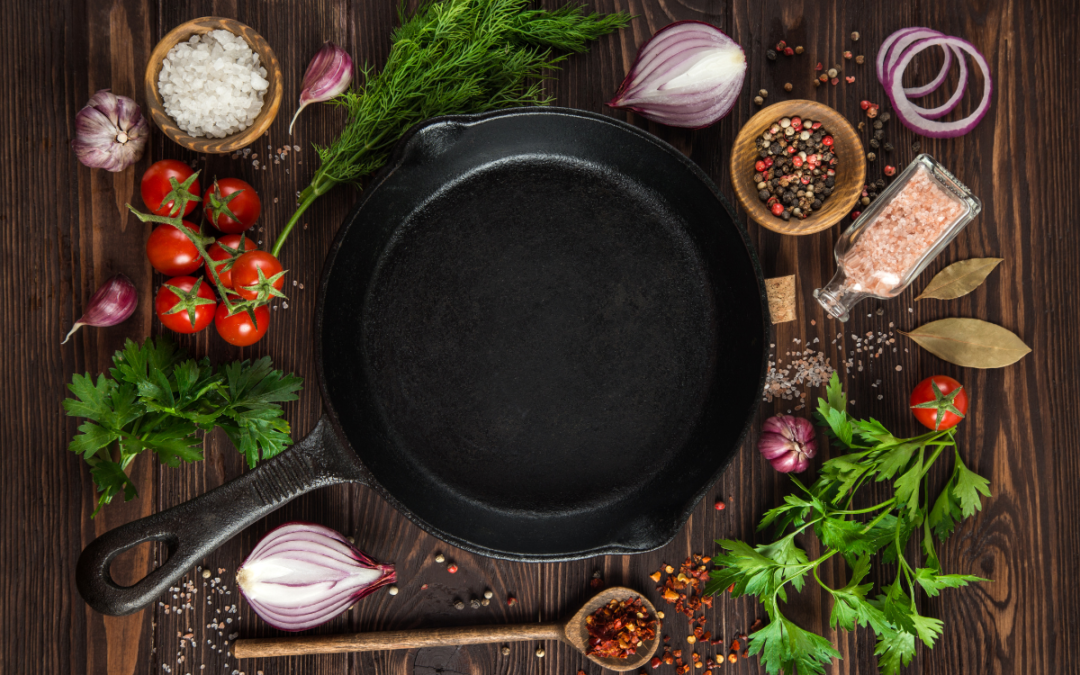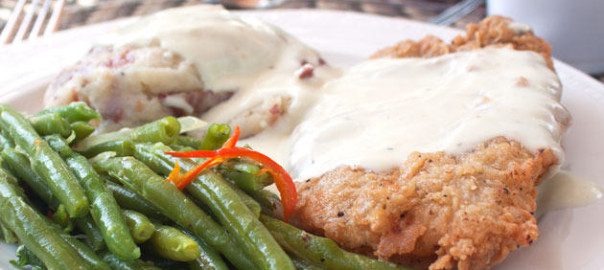From properly seasoning and cleaning your cast iron skillet to tried-and-true recipes, this is your guide to the best cast iron cooking.
“Nein! Keine seife!” Sternly blurted my grandfather. The tone of his voice surprised me so, I almost dropped the heavy, dark cast iron pot into the soap suds. Seeing my surprise, he walked to where I washing plates, knives and forks. In German he explained one never washes cast iron pots, skillets or Dutch ovens in soapy water because it removes the “season.”
My grandfather, then, led me the creek near where we had fried fish and potatoes over an open fire. There he taught me how to scrub cast iron using sand and water. According to him, doing so did not remove any of the oils in the slightly pores metal, which if removed would allow rust to form. He, too, told me the cast iron pot we used to fry fish was only used for frying fish and potatoes, because of the fish oil absorbed into the metal.
Once the cast iron skillet was cleaned, he thoroughly dried it. Then he rubbed “fresh” lard into the pan before storing it ’til the next time the big black pot would be used. I hoped and guessed would be soon!
I learned my first cast iron lessons back when I was almost five years old, quite a few years ago. It is a lesson I have never forgotten. To this day none of my cast iron pots and pans have ever been washed using soap. Some of that cast iron includes those I inherited from my grandfather who had inherited those same pans and pots from his father and his father before him.
Cast iron pots and pans are sometimes referred to as “Dutch ovens.” While Dutch ovens are cast iron pots, not all cast iron pots are Dutch ovens. The latter refers to a deep pot of various diameters and depths that have a cast iron lid, a lid upon which coals can heaped to heat from the top down, while also having coals below.
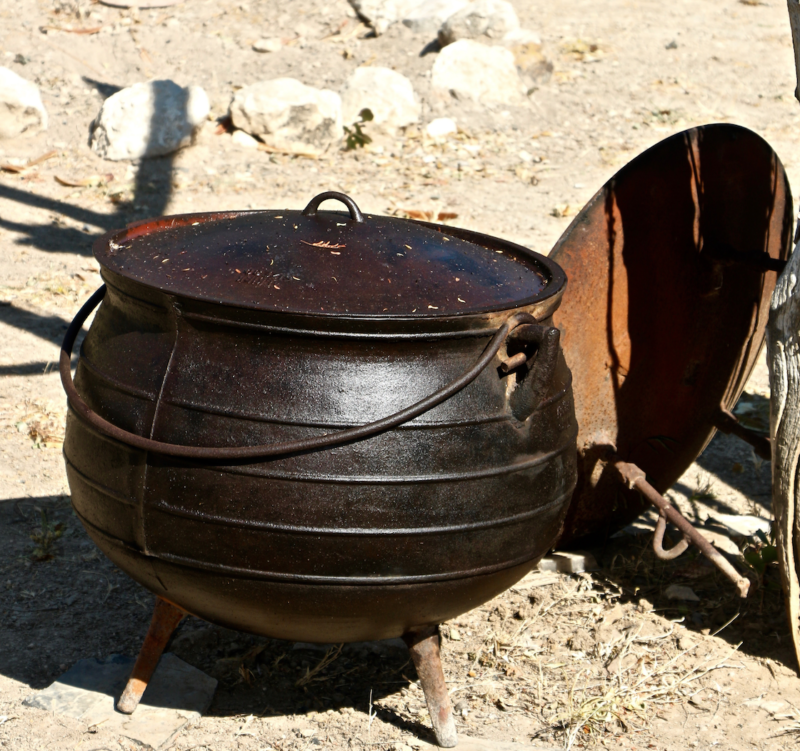
While Dutch ovens are cast iron pots, not all cast iron pots are Dutch ovens. Image courtesy Larry Weishuhn
Why cast iron cooking?
First a bit of a history lesson. Cast iron cookware has been used in preparing meals for over 2,000 years. Those who research such things credit the Hans Dynasty back in 220 A.D. as the first users of cast iron pots for cooking. Casting techniques with the passing of time improved. By the 1300s the use of cast iron for cooking had become extremely commonplace and popular, especially in Europe.
Moving forward, in 1707 Abraham Darby patented his sand casting method of creating cast iron pot and pans. Our modern day means of making cast iron cookware remains very similar to what Darby started over 300 years ago.
What is cast iron?
Cast iron is an iron-carbon alloy with a content of more than two percent carbon. It is made from “pig” iron, a product of melting iron ore in a blast furnace. In the molten form it can be poured to form pots, pans, lids and other such things as wood burning stoves.
Although considered too brittle for some metal purposes, cast iron works great for pots and pans. If properly seasoned and taken care such cookware will last for generations and is nearly indestructible. I suspect, too, an occasional “wrong doer” learned this the “hard way,” when a cast iron pot or skillet was used as a weapon to “settle them down.”
Most every early pilgrim family, mountain man or for that matter sourdough and covered wagon headed west took at least one or more cast iron pots and pans with them on there way to a new life or adventure. Undoubtedly too, every cattle drive with a chuck wagon had cast irons. For many years cast Iron pots and pans, including Dutch ovens were considered a required and valuable item. Some of us still feel that way.
But, why cast iron? As mentioned, pots and pans made of this material are practically indestructible, too, applied heat is evenly dispersed and distributed throughout the pot or pan. And the surface of pots and pans made of this material are non-stick if kept properly seasoned. Many of us who use and are proponents of cooking in cast iron believe doing makes whatever is prepared in them taste tremendously better, regardless whether cooked in your kitchen or outside over coals or an open fire.
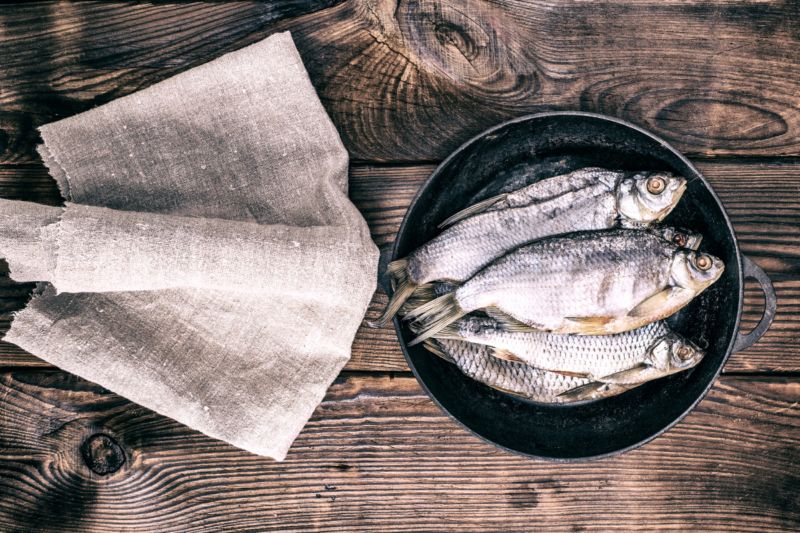
What can be cooked in cast iron is almost limitless, from soups to desserts and just about everything in between. Image: Canva
Seasoning and Storing Your Skillet or Dutch Oven
If you are thinking about using cast iron or have just purchased some, the first step is to properly “season” it. To do so, spread a thin layer of shortening, non-salted lard or vegetable oil over the pan and lid (if it has one). Place a piece of aluminum foil or large “cake pan” on your oven’s bottom rack. Place the cast iron pot, pan, skillet or Dutch oven on rack right above the foil or pan to catch any drippings thus keeping your oven clean. Turn the oven’s temperature to 375 degrees and heat the cast iron for one hour. After the hour’s end, turn off your oven and leave your cast iron inside to cool on its own. This should “season” your cookware.
Should your cast iron lose some of its “non-stick” qualities or develop rust spots, repeat the seasoning process. With new cast iron, consider seasoning it several times before using. Try to not use soapy water to clean your cast iron/Dutch oven. Although…there are some who claim it is permissible to do so. Luke Clayton, one of the best cast iron cooks I know, tells me he washes some of his Dutch ovens with soap and hot water, especially those he uses in preparing various dishes. Some claim the best soap to use on cast iron is Dawn liquid. Luke stresses, if you use soap and water, after rinsing, thoroughly dry the pan. Then apply a light coating of oil before storing. He recommends not using too much oil if you are going to store your cast irons for any length of time because it can create a “sticky” surface.
Personally, I see no reason to store cast iron for any extended period of time! Mine gets used nearly daily.
What can be cooked in cast iron?
What can be cooked in cast iron is almost limitless, from soups to desserts and just about everything in between. As can be imagined there are many recipes because of the great number of years cast iron has been used in preparing meals.
If you are interested, there are two books I can highly recommend. Barbecue, Biscuits and Beans by Bill Cauble and Cliff Teinert, two friends whose campfire and chuckwagon meals I have enjoyed numerous times. Their book is one of my favorites, complete with fabulous recipes. It is written by two of the best! Published by Bright Sky Press it is available many different places including Amazon. Cauble and Teinert both have long been cooking in cast iron Dutch ovens and skillets. They have cooked meals for U.S. Presidents, royalty, world dignitaries, hunters and cowboys. They too, have long served as judges at the Cowboy Hall of Fame Chuckwagon Cook-offs.
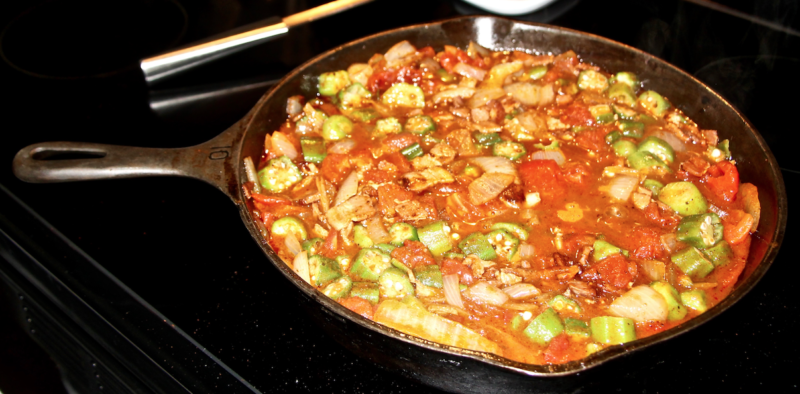
As can be imagined there are many recipes because of the great number of years cast iron has been used in preparing meals. Image courtesy Larry Weishuhn
The other book was written by my long-time dear friend J. Wayne Fears with whom I have shared many hunting camps and camp meals prepared by him, is The Lodge Book of Dutch Oven Cooking. “Lodge” as in the maker of the finest and best cast iron cookware available anywhere. J. Wayne, besides being a “regaler” of hunting tales extraordinaire, is an exceptional Dutch oven cook. He knows whereof he writes when it comes to cooking in cast iron! His Dutch oven cooking book and some of his thirty-plus others are available through Amazon and other sources.
Luke Clayton, mentioned earlier, with whom I do a weekly radio show available on www.catfishradio.org, as well as weekly podcast “Sporting Classics Campfire Talk with Larry Weishuhn and Luke Clayton”, and a weekly digital show, “A Sportsman’s Life” on Pride Outdoor Network is another of my cast iron heroes. Not a week goes by that we do not address cooking in cast iron. I also frequently address the topic in my personal podcast “DSC’s Campfires with Larry Weishuhn” available through waypointtv.com and pursuituptv.com as well as a lot of other places.
All this “talk” about cooking in cast iron is making me hungry! Think I will grab box of Hornady ammo, one of my Ruger No. 1s topped with a Trijicon scope and see what I might be able to add to the pot, made of cast iron of course!
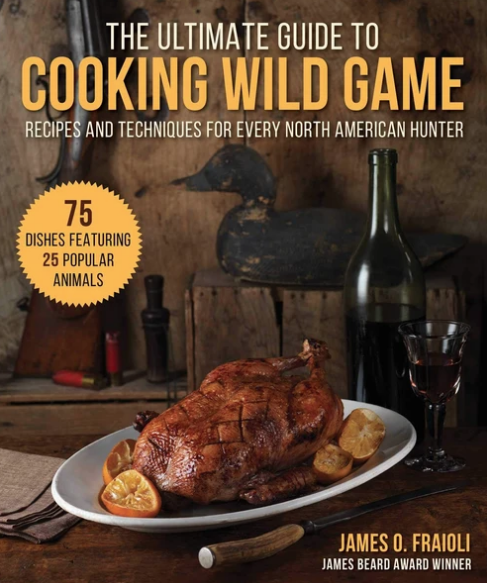 Within the pages of The Ultimate Guide to Cooking Wild Game, twenty-five popular game animals are highlighted and discussed. Amateur and experienced hunters alike will enjoy learning about each animal’s origin, range, migration and travel patterns, life span, size and weight, typical habitat, desired foods, why the particular animal is targeted, where it can be hunted, along with hunting tips and why it makes for excellent table fare.
Within the pages of The Ultimate Guide to Cooking Wild Game, twenty-five popular game animals are highlighted and discussed. Amateur and experienced hunters alike will enjoy learning about each animal’s origin, range, migration and travel patterns, life span, size and weight, typical habitat, desired foods, why the particular animal is targeted, where it can be hunted, along with hunting tips and why it makes for excellent table fare.
Whether you hunt for food, for pleasure, or for environmental management, know that you are engaging in a normal, natural, and innate human instinct that has been with mankind and our predecessors for hundreds of thousands of years and one that will be with us for many more years to come. Enjoy the hunt, and the tastes and flavors of your successes with a little help from this new book!

